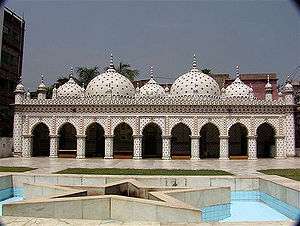Star Mosque
| Star Mosque | |
|---|---|
| তারা মসজিদ | |
 | |
| Basic information | |
| Location | Dhaka, Bangladesh |
| Geographic coordinates | 23°42′56″N 90°24′06″E / 23.715629°N 90.401728°E |
| Affiliation | Islam |
| Architectural style | Islamic architecture |
| Specifications | |
| Length | 21.34 m |
| Width | 7.98 m |
| Dome(s) | 5 |
| Minaret(s) | 4 |
Star Mosque (Bengali: তারা মসজিদ; also known as Tara Masjid), is a mosque located in Armanitola area, Dhaka, Bangladesh. The mosque has ornate designs and is decorated with motifs of blue stars. It was built in the first half of the 19th century by Mirza Golam Pir (Mirza Ahmed Jan).[1]
Historical background
Star Mosque was first built by Mirza Ghulam Pir, as a three domed oblong edifice. But an over enthusiastic and zealous merchant named Ali Jan Bepari completely remodeled and reconstructed it with extremely delicate and richly colored tiles of variegated patterns. Ali Jan has added the new verandah, that is mentioned in the introduction, on the east and spent lavishly on importing Japanese and English decorated China clay tiles to improve the inner and outer show of the mosque. It is now a five domed structure. In 1987, two domes have been raised on an extension to the northern side without any respect to its antiquity, architectural style and decoration.
Architecture
Built in the Mughal style by Mirza Ghulam in the late 18th century, this mosque was originally a simple rectangular mosque, measuring 33' x 11' with three doorways on the east façade (main façade) and one on the north wall and another on the south wall. Three domes crowned the mosque, the central one being the larger. Towers accented the corners and the façades displayed plastered panel decoration. In early 20th century, Ali Jan Bepari financed its renovation when a front verandah was added. The surface was redone in ‘Chini Tikri’, a popular broken china decoration. The mosque is one of the very few examples of exclusive chinitikri mosaic, found in the striking blue star mosaic, which gave the mosque its name Star Mosque. In 1987, the prayer hall was extended by the Department of Architecture to include two more domes.[2] It was decorated with imported china clay tiles and used both methods of applying chinitikri and used solid color, cur clay tiles and formed patterns by placing the colored tiles in white plaster. The domes and the exterior are covered with different colored star shaped china clay tiles. The upper portion of the eastern façade also incorporates a crescent motif. The work assumed another texture by using assorted glazed tiles on the interior. The three mibrabs and the doorways are decorated with mosaic floral pattern. A plant and vase motif is repeated as a decorative element on the pendantive and the interior of the verandah wall.
Exterior decoration
.jpg)
In early 20th century, Ali Jan Bepari, a local businessman, financed the renovation of the mosque and added a new eastern verandah. The surface was redecorated with Chinitikri work (mosaic work of broken China porcelain pieces), a decorative style that was popular during the 1930s. The mosque, which previously lacked any historical significance, is one of the few remaining architectural example of the Chinitikri (Chinese pieces) method of mosaic decoration. This decorative technique is found in the striking star motif that is in part the reason for the mosque's current acclaim and popular name, Star Mosque or Sitara Masjid. In 1987, the Ministry of Religious Affairs commissioned Giasul Huque and Zahiruddin Zahiruddin to make additions to the prayer hall, which was extended to include two more domes.
The mosque is decorated with Japanese and English china clay tiles and utilized both methods of the Chinitikri application. One approach uses solid color, cut clay tiles and form patterns through the placement of these colored tiles in white plaster. The domes and the exterior surface are covered with different colored star shaped China clay tiles. The upper portion of the eastern façade also incorporates a crescent motif.
Interior decoration

Chinitikri tile work assumes another texture by using assorted pieces of different designs of glazed tiles on the interior surfaces of the mosque. The three mihrabs and the doorways are decorated with mosaic floral pattern. A plant and vase motif is repeated as a decorative element on the pendentives as well as on the interior of the verandah wall. As a decorative element, the Japanese Fujiyama motif, is found on the surface between the doors.
References
- ↑ Begum, Ayesha (2012). "Star Mosque". In Islam, Sirajul; Jamal, Ahmed A. Banglapedia: National Encyclopedia of Bangladesh (Second ed.). Asiatic Society of Bangladesh.
- ↑ http://www.bangladesh.com/religious-sites/star-mosque/
- Haque, Enamul. 1983. Islamic Art Heritage of Bangladesh. Dhaka: Bangladesh National Museum, 98.
- Ahmed, Nazimuddin. 1984. Discover the Monuments of Bangladesh. Dhaka: University Press Limited, 181.
- Hasan, Syed Mahmudul. 1981. Dacca: The City of Mosques. Dhaka: Islamic Foundation, 46.
- Imamuddin, Abu H. 1993. Architectural Conservation Bangladesh: Asiatic Society of Bangladesh, 239.
- Rahman, Mahbubur. 2009. Old but new :: new but old : architectural heritage conservation: UNESCO, 339.
- ABM, Hussain. 2007. The Archaeological Heritage of Bangladesh. Dhaka: Asiatic Society of Bangladesh.
- Ahmed, Sharif Uddin. 1991. Dhaka Past Present Future. Dhaka: Asiatic Society of Bangladesh.
External links
- A photo blog post on Tara Mosjid /Star Mosque in Kothay
_002.jpg)